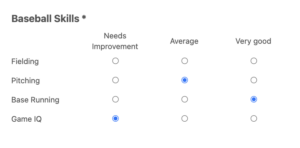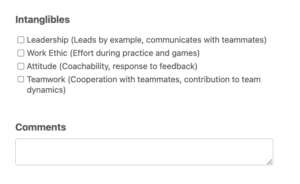
Here’s a guide to creating an baseball player evaluation form that meets your program’s or Academy’s unique needs.
We’ll cover:
Before you start creating the feedback form, it’s important to understand the exact purpose of the evaluation. This will shape the content of the form and ensure that you’re collecting the right information.


Using a clear grading scale will ensure that all evaluators rate players consistently. A common scale, such as 1 to 5 or 1 to 10, is easy to use and gives evaluators enough flexibility to distinguish between different skill levels.
Example: Create a chart or grid with the skill on one side and the corresponding rating on the other for each skill (e.g., hitting, fielding, etc.).
Hitting Power:

This helps evaluators provide quantitative feedback, but be sure to clearly define each point on the scale so that different evaluators interpret the scale in the same way.
📌 Pro Tip: Having worked with several clubs and academies, I’ve found that the younger generation of coaches appreciate the convenience of managing everything from their iPad or smartphone. Parents and players also appreciate the ability to track and view progress online in real time.
While the rating scale provides a snapshot of a player’s skills, the comments section allows for more nuanced feedback. This section is especially helpful when evaluating potential or specific strengths/weaknesses that numbers alone may not capture.
For example, a player may score high on contact hitting, but struggle with timing on inside pitches. Comments can highlight such details that would be missed in a numerical rating. They also provide context for standout plays or situations that don’t fit neatly into the categories provided.

In addition to technical skills, a great player is often defined by his physical and mental makeup. Including these attributes allows you to evaluate the less tangible qualities that are still critical to success:
These can either be graded using a grading scale or left open for written comments.
Once you’ve created the form, test it in real-world scenarios, such as a tryout or practice. This will help:
After testing, get feedback from other coaches and evaluators. Adjust the form based on their input to create a streamlined and efficient tool for future evaluations.
Activity Messenger also allows you to create a baseball registration form that includes online payments, liability waivers, attendance tracking, and even SMS communication with participants.
Here is a Baseball Progress Report Template that was created using Activity Messenger. Test it out and see if you like it.